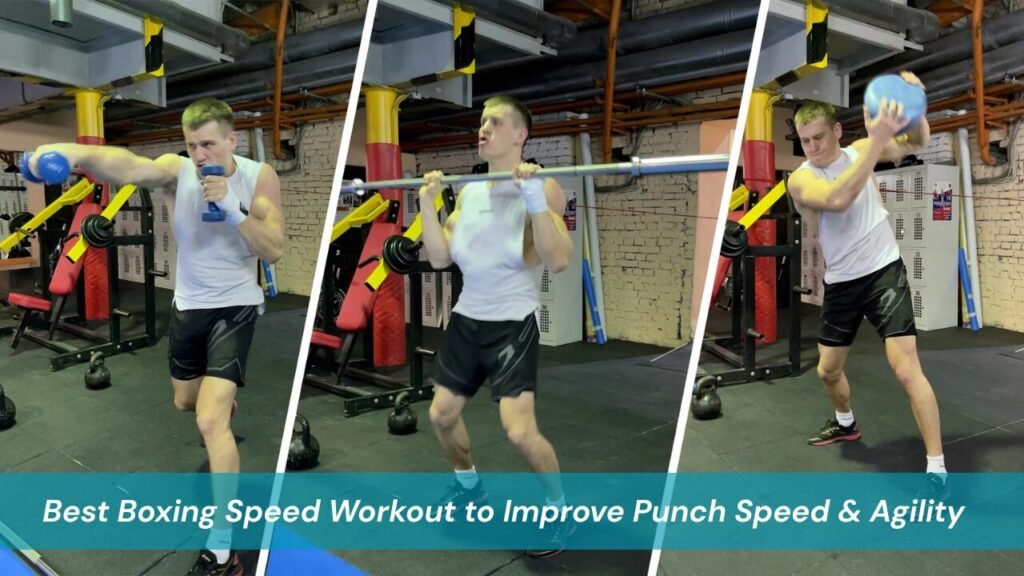Looking to get faster in the ring? A boxing speed workout is one of the most powerful ways to sharpen your hand speed, boost reaction time, and develop agility without sacrificing proper technique. Speed is more than just quick punches, it’s the ability to control the pace of the fight, strike before your opponent reacts, and slip counters with precision. A fast boxer often dictates the rhythm of a match, making it harder for an opponent to find openings. Whether you are a beginner hoping to build sharper reflexes or an experienced fighter searching for that competitive edge, training specifically for speed can transform your boxing skills and elevate your overall performance
Key Takeaways
- Boxing speed workouts improve hand speed, reaction time, and agility without compromising technique.
- True speed relies on relaxation, compact mechanics, rhythm, and precise timing rather than raw effort.
- Structured rounds, accessory drills, and progressive training help track and enhance performance.
- Minimal equipment and proper technique cues can still develop fast, effective punches and mobility.
What Makes a Great Boxing Speed Workout?
A great speed workout is not just about throwing punches as quickly as possible. Instead, it is about training your neuromuscular system to fire efficiently while maintaining crisp technique. The foundation of true boxing speed lies in relaxation. Tension slows your movements, while loose shoulders and relaxed hands allow punches to travel faster and snap back to guard without wasted effort. Compact mechanics also play an important role. Shorter punches and tighter footwork travel less distance, which makes them naturally faster than wide or sloppy movements.
Rhythm and timing are equally critical. A boxer who can release a jab with precision and retraction on a steady rhythm will always appear faster than someone throwing wild, uncontrolled flurries. Reaction drills are another key feature of any effective speed session because the ability to respond quickly to a visual or auditory cue is often what separates landing a clean punch from getting countered. Finally, great speed training avoids pushing you into excessive fatigue. Unlike conditioning workouts, these sessions should stop before technique breaks down, keeping quality high at all times.
The Essential Warm-Up
Before diving into your main training session, you need to prime your body for rapid movements. A proper warm-up increases blood flow, loosens joints, and activates the muscles used for fast punches and quick footwork. One of the best ways to prepare is jump rope. Starting with ninety seconds at a comfortable rhythm before transitioning into short bursts of faster steps helps you find rhythm while engaging your calves, shoulders, and coordination. Dynamic upper-body work, such as arm circles or band pull-aparts, ensures your shoulders are loose enough for fast hand movement.Neck and thoracic mobility also play a role since quick head movement depends on a mobile upper spine. Gentle nods, side rotations, and open-book stretches free up these areas so you can slip punches more fluidly. The final part of the warm-up should be light shadowboxing. Keeping the intensity at about fifty percent while focusing on crisp retractions will activate the nervous system without creating fatigue, setting the tone for the workout ahead.
The Round-Based Boxing Speed
The core of this training routine is structured in two- to three-minute rounds with thirty to forty-five seconds of rest in between. This mimics real fight conditions but focuses specifically on boxing speed workout rather than power or endurance. Each round has a clear purpose, and together they form a complete routine that builds speed in all dimensions of boxing.
The first set of rounds focuses on shadowboxing with speed. By working at seventy to eighty percent effort, you can prioritize clean mechanics while still pushing the tempo. Drills such as rapid one-twos, quick double jabs, and short three-punch combinations are perfect here. The key is to throw sharp, fast shots, immediately retract them to guard, and exit with quick head movement or a step out.
Jump rope is another staple in this speed workout. Alternating twenty seconds of fast skipping with ten seconds of regular rhythm builds quick foot turnover while reinforcing coordination. The constant change in rhythm also teaches you to accelerate and decelerate efficiently, an important aspect of controlling the pace in the ring.
The double-end bag comes next. This piece of equipment is one of the most valuable for speed development because it forces you to time your punches with its unpredictable rebounds. Working from single shots into doubles and then three-punch bursts helps you develop rhythm while sharpening your reflexes. Tracking the bag with your eyes ensures that your speed is connected to timing rather than just raw hand movement.
Unlike the double-end bag, which challenges reactivity, the speed bag builds rhythm, shoulder endurance, and consistent cadence. Short rounds of sixty to ninety seconds at high speed, while counting the number of strikes you achieve, create a measurable way to track progress over time. The constant rhythm improves your ability to maintain fast hand movement under fatigue.
Heavy bag work should not be ignored. Instead of slow, powerful shots, the focus here is on short, high-volume flurries. Combinations of five to ten punches thrown rapidly and snapped back before moving lightly around the bag simulate real fight exchanges. Adding quick steps out or pivots after each burst builds the habit of combining speed with mobility.
Finally, a sprint finisher can be added. Short bursts of twenty seconds at full speed, followed by forty seconds of recovery, push your nervous system to move explosively. These intervals translate directly to boxing, where sudden bursts of speed often decide exchanges.
Technique Cues to Punch Faster
The difference between looking fast and actually being fast often comes down to technique. The most important cue is to stay relaxed until the moment of impact. Tensing up before or during a punch slows you down and drains energy. Instead, release the punch quickly, snap it back, and tighten your fist only as it lands. Breathing also plays a major role. Exhaling sharply through the mouth with every strike keeps your rhythm steady and prevents holding unnecessary tension.
Fast punches also rely on hip and shoulder rotation. When your body moves as a unit, the kinetic chain transfers energy efficiently and allows your arms to snap like whips. To further enhance speed, shorten the path of each punch. Straight shots should travel directly to the target and return on the same line. Wide swings take longer and leave you open to counters. Finally, learning to angle off after each burst of punches resets your stance and ensures that you remain balanced while creating opportunities for follow-up shots.
Accessory Drills That Build Speed
In addition to round-based work, accessory drills can help reinforce the qualities needed for faster movement. Agility ladder exercises, such as in-in-out-out or lateral shuffles, train your feet to move rapidly in small, precise steps. Cone drills with shuffles and pivots replicate fight situations where you need to cut angles quickly. Medicine ball chest passes, thrown with maximum speed against a wall or to a partner, improve explosive release and hand coordination.
Plyometric push-ups, such as clapping push-ups or push-ups onto a low box, are excellent for building upper-body power with speed. These movements condition your fast-twitch muscle fibers to fire more rapidly, leading to quicker punches. Band-resisted punches are another valuable tool. By punching with resistance and then removing the band, your nervous system adapts to moving faster, a principle known as overspeed training.
Weekly Training Plan and Progressions
To see consistent improvement in your Boxing Speed Workout and performance, it’s important to follow a structured weekly plan. For the first two weeks, aim for two sessions per week. Keep rounds at two minutes and prioritize clean mechanics, sharp retraction, and establishing rhythm. In weeks three and four, increase to three sessions per week and add an extra round on both the double-end and heavy bag to gradually increase your workload.
By weeks five and six, the goal is to improve density rather than just volume. Keep the same number of rounds, but reduce rest intervals to thirty seconds and add one extra flurry during each round. Progress should be tracked through measurable metrics such as the number of strikes completed on the speed bag, successful clean touches on the double-end bag, or the number of fast flurries you can execute per heavy-bag round. Over time, these indicators will show you exactly how much your speed has improved.
Mistakes to Avoid in Speed Training
Many boxers sabotage their progress by approaching speed training incorrectly. One of the most common mistakes is muscling every punch. Speed comes from relaxation and precision, not from excessive effort. Over-tensing slows you down and makes punches easier to predict. Another mistake is letting technique collapse under fatigue. Unlike conditioning workouts, speed training is not about pushing to exhaustion. If your punches get sloppy, stop and recover before resuming.
Taking long, static rests also diminishes the purpose of the workout. Short rests keep your nervous system engaged and train you to recover quickly between bursts, just as you would in a fight. Finally, neglecting footwork is a critical error. Hand speed is only as useful as the footwork that positions you to land punches effectively.
Minimal-Equipment Speed Workout
Not every boxer has access to a gym or specialized equipment, but that should not stop you from training speed. Shadowboxing at a fast rhythm with constant angled exits develops hand speed and mobility. Plyometric push-ups, performed in low reps with full recovery, enhance explosive upper-body strength. High-knee sprints in place, alternating thirty seconds of all-out effort with thirty seconds of rest, replicate the rapid bursts required in the ring. Reflex drills, such as tossing and catching a tennis ball off a wall, keep your reaction time sharp even without boxing gear.
Conclusion
Speed is one of the most valuable assets in boxing, often making the difference between landing punches and getting hit. A well-designed boxing speed workout trains relaxation, rhythm, reaction, and efficient mechanics rather than relying on raw effort alone. By following structured rounds, applying proper technique cues, and including both accessory drills and progressions, you can steadily increase your hand speed, sharpen your footwork, and become more elusive in the ring.
FAQs
How many times per week should I train for boxing speed?
Most boxers see great results with two to three focused speed sessions each week. This frequency allows you to improve hand speed, reaction time, and agility without risking overtraining. It’s best to spread these sessions out with at least one rest or technical day in between so your nervous system has enough time to recover.
How long should a speed session last?
A dedicated speed session should take between twenty-five and forty-five minutes, depending on your fitness level. Unlike conditioning workouts, speed training focuses on short, sharp rounds with proper rest. Going much beyond forty-five minutes usually leads to fatigue, which lowers punch quality and slows reaction speed.
Does strength training make you slower in boxing?
Not if it’s done correctly. Traditional heavy, slow lifts can limit explosiveness if that’s all you do, but incorporating explosive strength work such as plyometrics, medicine ball throws, and resistance band training actually develops fast-twitch muscle fibers. This helps you punch quicker and maintain speed while still building power.




